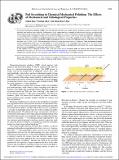| dc.contributor.author | Kim, Sanha | |
| dc.contributor.author | Saka, Nannaji | |
| dc.contributor.author | Chun, Jung-Hoon | |
| dc.date.accessioned | 2017-04-11T19:13:09Z | |
| dc.date.available | 2017-04-11T19:13:09Z | |
| dc.date.issued | 2014-04 | |
| dc.date.submitted | 2014-03 | |
| dc.identifier.issn | 2162-8769 | |
| dc.identifier.issn | 2162-8777 | |
| dc.identifier.uri | http://hdl.handle.net/1721.1/108056 | |
| dc.description.abstract | In chemical-mechanical polishing (CMP), even the soft pad asperities may, under certain conditions, generate scratches on the relatively hard surfaces being polished. In the present study, contact mechanics models of pad-induced scratching are formulated, and the effects of the hardness of the surface layers and of pad asperities as well as the interfacial friction are elucidated. Additionally, scratch-regime maps are proposed to provide criteria for scratching hard surface layers by the softer pad asperities. Furthermore, scratching indexes are introduced to predict the proportion of asperities in contact that are likely to scratch. The contact mechanics models of scratching have been validated by sliding experiments with two commercial CMP pads (Pad A and IC1000) and various thin-films (Al, Cu, SiO[subscript 2], Si[subscript 3]N[subscript 4], TiN and three low-k dielectrics) using deionized water as a “lubricant.” Both the theoretical models and the experimental results show that the number of scratches increases as the scratching index exceeds 0.33. Al and Cu layers are found to be more susceptible to pad scratching due to their low hardness and high interfacial friction. The scratch-regime maps provide practical guidelines for mitigating pad scratching in CMP. | en_US |
| dc.description.sponsorship | Samsung (Firm) | en_US |
| dc.language.iso | en_US | |
| dc.publisher | Electrochemical Society | en_US |
| dc.relation.isversionof | http://dx.doi.org/10.1149/2.027405jss | en_US |
| dc.rights | Creative Commons Attribution 4.0 International License | en_US |
| dc.rights.uri | http://creativecommons.org/licenses/by/4.0/ | en_US |
| dc.source | Electrochemical Society | en_US |
| dc.title | Pad Scratching in Chemical-Mechanical Polishing: The Effects of Mechanical and Tribological Properties | en_US |
| dc.type | Article | en_US |
| dc.identifier.citation | Kim, S., N. Saka, and J.-H. Chun. “Pad Scratching in Chemical-Mechanical Polishing: The Effects of Mechanical and Tribological Properties.” ECS Journal of Solid State Science and Technology 3.5 (2014): P169–P178. | en_US |
| dc.contributor.department | Massachusetts Institute of Technology. Laboratory for Manufacturing and Productivity | en_US |
| dc.contributor.mitauthor | Kim, Sanha | |
| dc.contributor.mitauthor | Saka, Nannaji | |
| dc.contributor.mitauthor | Chun, Jung-Hoon | |
| dc.relation.journal | ECS Journal of Solid State Science and Technology | en_US |
| dc.eprint.version | Final published version | en_US |
| dc.type.uri | http://purl.org/eprint/type/JournalArticle | en_US |
| eprint.status | http://purl.org/eprint/status/PeerReviewed | en_US |
| dspace.orderedauthors | Kim, S.; Saka, N.; Chun, J.-H. | en_US |
| dspace.embargo.terms | N | en_US |
| dc.identifier.orcid | https://orcid.org/0000-0002-3548-6173 | |
| dc.identifier.orcid | https://orcid.org/0000-0002-8480-5572 | |
| dc.identifier.orcid | https://orcid.org/0000-0003-1607-3581 | |
| mit.license | PUBLISHER_CC | en_US |
